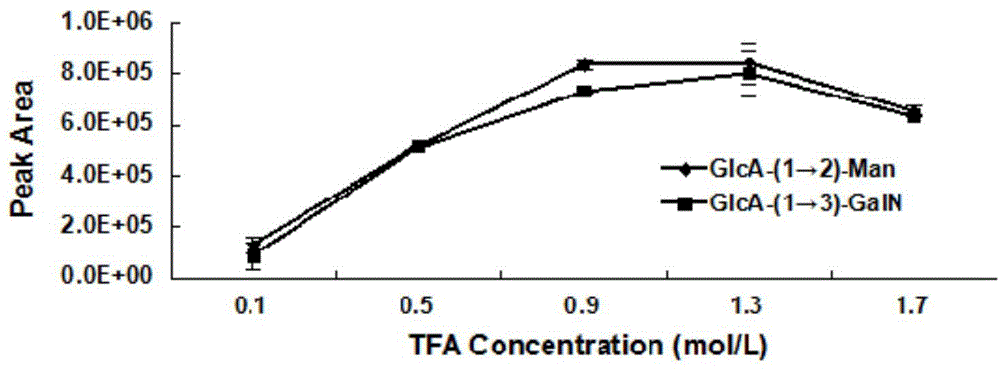Method for identifying uronic acid-containing polysaccharide in biological tissue
A technology of biological tissue and alkydose polysaccharides, applied in the direction of measuring devices, instruments, scientific instruments, etc., can solve the problems of difficult wide application, expensive degrading enzymes and oligosaccharide standard products, and difficult to accurately identify types, so as to avoid separation and purification The effect of the process
- Summary
- Abstract
- Description
- Claims
- Application Information
AI Technical Summary
Problems solved by technology
Method used
Image
Examples
Embodiment 1
[0040] (1) Prepare a series of TFA solutions containing 2mg / mL chondroitin sulfate and 2mg / mL abalone polysaccharide AGSP, the TFA concentrations are 0.10, 0.30, 0.90, 1.30, 1.70mol / L, hydrolyze at 110℃ for 2h ;
[0041] (2) Prepare a series of 1mol / L TFA solutions containing 2mg / mL chondroitin sulfate and 2mg / mL abalone polysaccharide AGSP, and hydrolyze them at 90°C, 100°C, 110°C, 120°C, and 130°C for 2 hours;
[0042] (3) Prepare a series of 1mol / L TFA solutions containing 2mg / mL chondroitin sulfate and 2mg / mL abalone polysaccharide AGSP, and hydrolyze them at 110°C for 1h, 2h, 3h, 4h, 5h respectively;
[0043] (4) Use L 4 (2 3 ) Orthogonal table Orthogonal experiments were performed on TFA concentration (0.9mol / L1.3mol / L), acid hydrolysis temperature (105°C, 115°C), acid hydrolysis time (2h, 3h).
[0044] (5) Add 1 mL of water to the acid hydrolyzate obtained in steps (1)-(4), remove TFA by rotary evaporation, and repeat three times to achieve the purpose of acid remova...
Embodiment 2
[0055] (1) Take fresh equilateral shallow clams, square clams, Chinese clams, razor clams, and mussels with thick shells, remove the shells and viscera, and homogenize. Weigh 15g of the homogenized raw materials and put them in 75mL of KH with pH=8. 2 PO 4 In the buffer solution, add 0.5% trypsin to digest for 4 hours, then add 0.5% papain to digest for 3 hours, then inactivate the enzyme with boiling water at 100°C for 5 minutes; centrifuge the hydrolyzate at 10,000 r / min for 20 minutes to take the supernatant solution; add 1.5 times the volume of ethanol to the supernatant for alcohol precipitation overnight; after alcohol precipitation, centrifuge at 4000r / min for 15min to collect the precipitate, and freeze-dry the precipitate to obtain crude polysaccharide dry powder.
[0056] (2) Accurately weigh 50 mg of crude polysaccharide dry powder into a 5 mL hydrolysis tube, and add 1 mL of 1.3 mol / L trifluoroacetic acid to the hydrolysis tube for hydrolysis at 105 °C for 3 hours;...
Embodiment 3
[0062] (1) Take 1 g of sea cucumber boiled liquid freeze-dried powder in 25 mL of KH with pH=8 2 PO 4 In the buffer solution, add 0.5% trypsin to digest for 4 hours, then add 0.5% papain to digest for 3 hours, then inactivate the enzyme with boiling water at 100°C for 5 minutes; centrifuge the hydrolyzate at 10,000 r / min for 20 minutes to take the supernatant solution; add 1.5 times the volume of ethanol to the supernatant for alcohol precipitation overnight; after alcohol precipitation, centrifuge at 4000r / min for 15min to collect the precipitate, and freeze-dry the precipitate to obtain crude polysaccharide dry powder.
[0063] (2) Accurately weigh 20 mg of crude polysaccharide dry powder into a 5 mL hydrolysis tube, and add 1 mL of 1.3 mol / L trifluoroacetic acid to the hydrolysis tube for hydrolysis at 105 °C for 3 hours; add 1 mL of water to the acid hydrolyzate, and use a rotary The evaporator removes the solvent under reduced pressure, repeats three times, and removes t...
PUM
 Login to View More
Login to View More Abstract
Description
Claims
Application Information
 Login to View More
Login to View More - R&D
- Intellectual Property
- Life Sciences
- Materials
- Tech Scout
- Unparalleled Data Quality
- Higher Quality Content
- 60% Fewer Hallucinations
Browse by: Latest US Patents, China's latest patents, Technical Efficacy Thesaurus, Application Domain, Technology Topic, Popular Technical Reports.
© 2025 PatSnap. All rights reserved.Legal|Privacy policy|Modern Slavery Act Transparency Statement|Sitemap|About US| Contact US: help@patsnap.com



